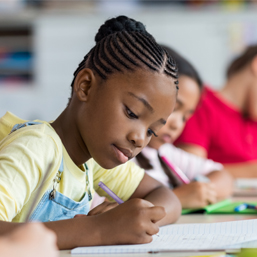
For kids, transitioning to a new school can be difficult. Whether it is your child’s first day of elementary school, their first day of high school, or you’re moving to a new school district, starting a new school can affect your child’s academic performance, social development, and mental state. But there are things you can do before and during your child’s switch to a new school to help them feel and become comfortable in an unfamiliar environment.
Ages three to four
Settling in - For some young children, learning to cope with an unfamiliar environment, as well as separating from you, can be overwhelming or it can go smoothly. How a preschooler reacts emotionally and socially may have more to do with their temperament, needs, interests, and experiences, such as previous school attendance, than their specific age.
Showing regressive behaviors - Some threes and fours are unsure of their unfamiliar environment and vary in their adjustment times. Do not be surprised if your child reverts to familiar, less-mature behaviors of younger children (baby talk, clinging). In this way, your child may be telling you to stay a little longer at drop-off time, or they may be letting their teacher know that they need some one-on-one time with them, like cuddling on the couch in the library for a quiet story together. By age three, most children who have had opportunities to make strong attachments to their parents have achieved the major emotional milestone of keeping their parent(s) in their mind while they are separated from them for a few hours. However, a longer period may be difficult for some threes at first.
Finding comfort - Familiarity is comforting and helps preschoolers make the necessary transition. Bringing a familiar, comforting item to school helps threes and fours to feel safe and secure at first. Then they begin to adapt as they substitute other things in the environment. Although three-year-olds refer to other children as their friends, it is usually the materials in their environment that attract them initially. On the other hand, fours become excited about seeing their friends from last year or moving up with them from their three-year-old class.
Encourage comfort with:
Ages five to six
Kindergarten children react to their unfamiliar environment in a variety of ways. Some have never been to school before, while others have participated in a preschool or daycare program. Each child brings their own preferences and interests. Even though many five-year-olds have some experience with a ‘program,’ they are often hit with the reality of going off to kindergarten - this is a huge change!
Making adjustments - By age five, many children have started to develop an interest in carrying on conversations with new children and adults. While some new kindergartners may still fear unfamiliar people, most have come to trust the school setting as a safe place to meet others. Often, it can take a few days of acclimation before the quietest child starts to participate in short conversations.
Finding play partners - The desire and ability to organize and interest others in play is an important part of being a five- and six-year-old. This inclination can help many children overcome their fear of the new environment because they are drawn to playing with others. Many children start kindergarten with this ability, but almost all develop it quickly through a good play-based program. Interestingly, this social interaction skill is often paired with the school-ager’s desire to play with one or two children at a time. This makes the introduction of learning centres an important part of setting up the new environment.
Creating familiarity - Feeling ‘grown-up’ is important to most five- and six-year-olds. When they enter their new environment, they want to feel successful and knowledgeable right away. Therefore, it’s important for children to find things that remind them of preschool. Then you can gradually add new challenges and responsibilities. It is also helpful to look at how children’s different adjustment styles play out in the beginning of the school year.
Making individual adjustments - It is important to be supportive and allow your child the opportunity to play the observer role as needed. At the same time, make it clear that they are invited and encouraged to participate. You probably have also experienced a child who is so excited to be at a new school that they fly from one activity to another without touching down. While it’s good that this child appears to separate from their parent(s) easily, this type of behavior can signal a basic insecurity that is manifesting itself in ‘flighty’ activity. This child often needs as much reassurance as the quiet, shy child.
Ages seven to 11
Start the conversation early. Give your child as much time as you can to process the upcoming change. Ask your child what they’re nervous/frightened about with this change.
Offer support:
Read Part Two in our Chinook 2022 Issue.
Marlowe Gelmon, M.Sc., Behavioral Neuroscience Behavioral Therapist, brings more than 16 years of experience in behavioral therapy practices and research. She is a keynote speaker and writer. Parenting is filled with new challenges. She is here to help you and your child/teen overcome some of these challenges. For more information, call 587-897-0243, email This email address is being protected from spambots. You need JavaScript enabled to view it., or visit positiveneurohealth.com.
Calgary’s Child Magazine © 2024 Calgary’s Child